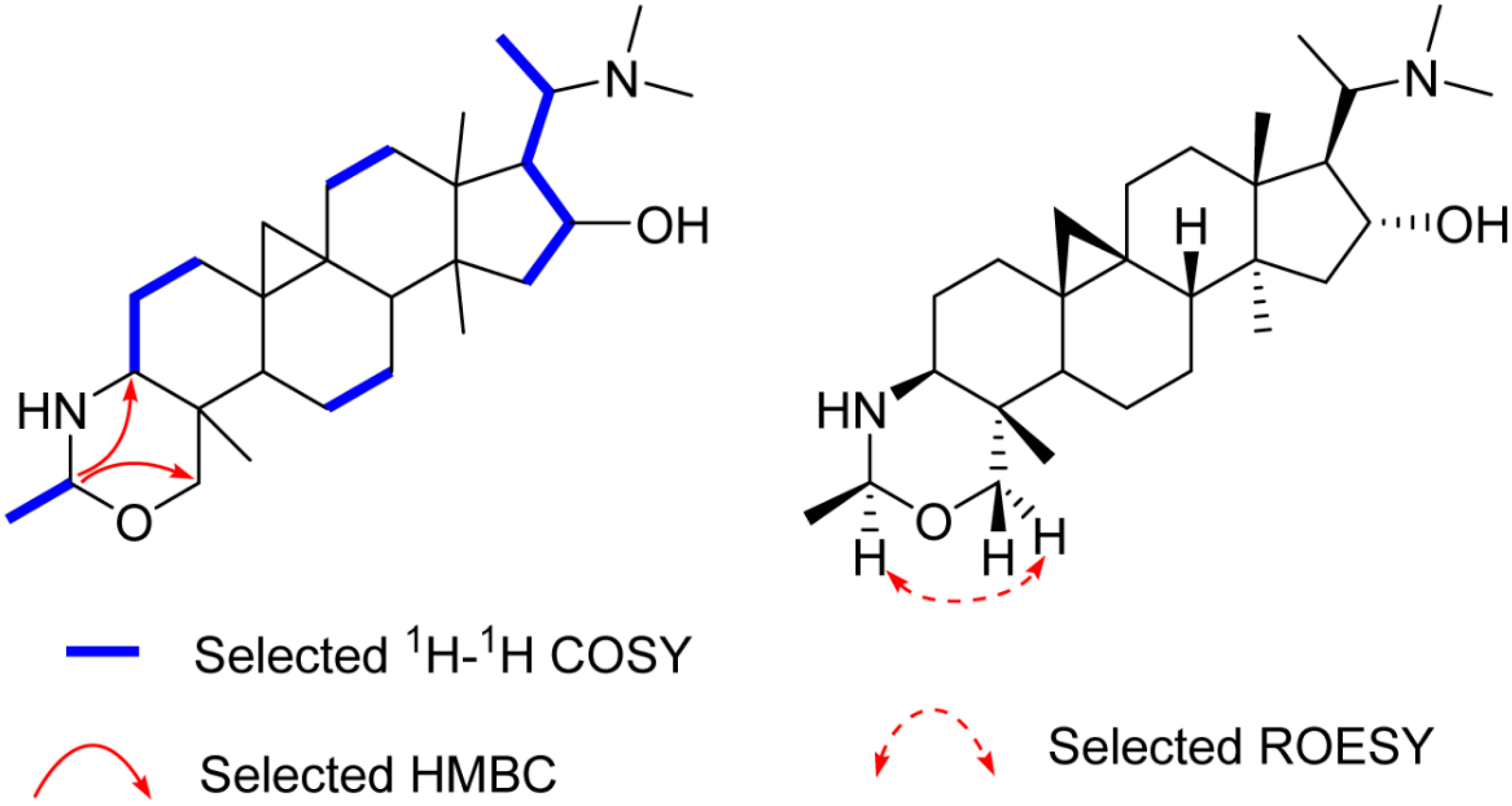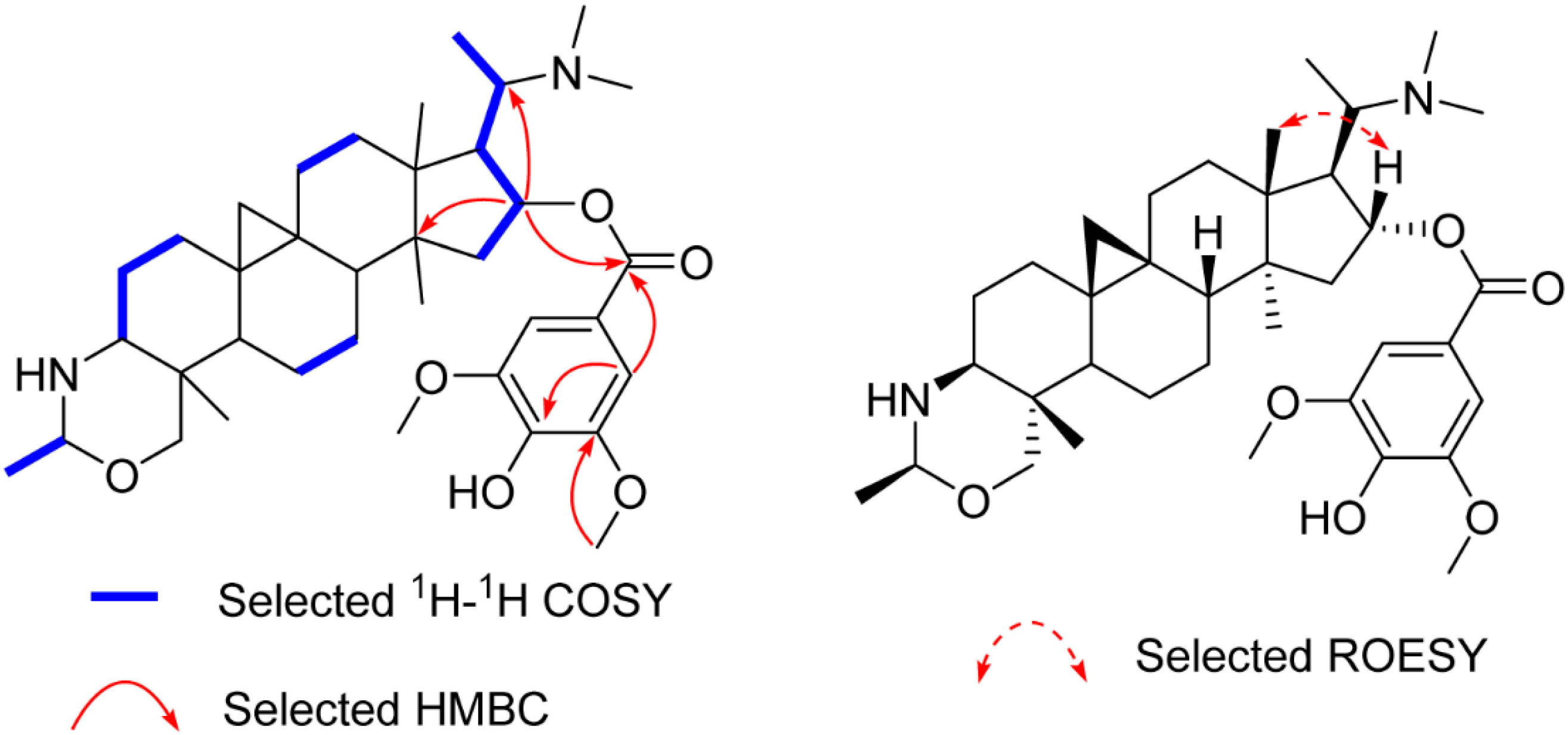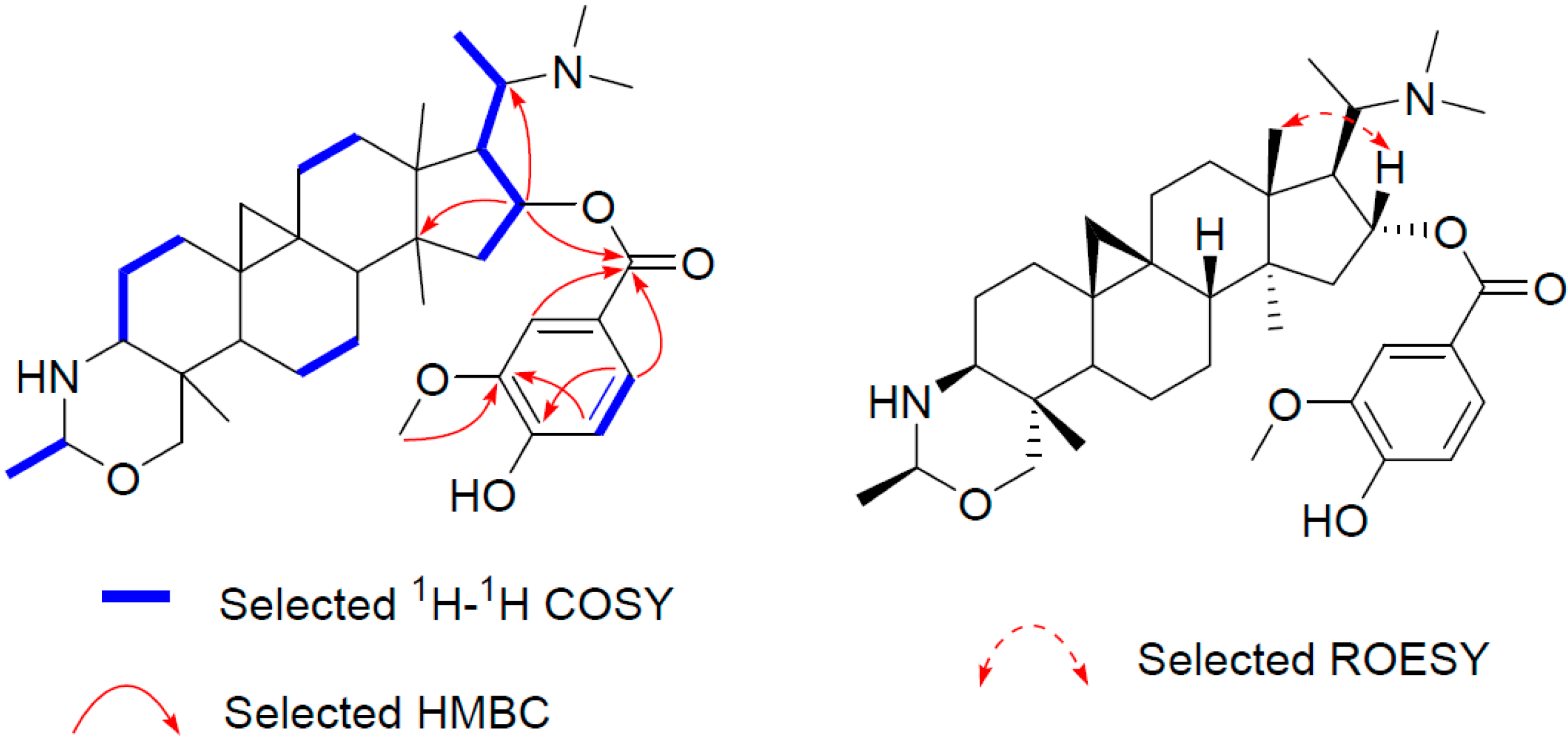Cytotoxicity of Triterpenoid Alkaloids from Buxus microphylla against Human Tumor Cell Lines
Abstract
:1. Introduction
2. Results and Discussion
3. Experimental Section
3.1. General Information
3.2. Plant Material
3.3. Extraction and Isolation
3.4. Cytotoxicity Assay
4. Conclusions
Supplementary Materials
Acknowledgments
Author Contributions
Conflicts of Interest
References
- Zhang, J.; Qin, X.Y.; Zhang, S.D.; Xu, X.S.; Pei, J.P.; Fu, J.J. Chemical constituents of plants from the Genus Buxus. Chem. Biodivers. 2015, 12, 1289–1306. [Google Scholar] [CrossRef] [PubMed]
- Yan, Y.X.; Sun, Y.; Chen, J.C.; Qiu, M.H. Triterpenoid alkaloid derivatives from Buxus rugulosa. Nat. Prod. Bioprospect. 2011, 1, 71–72. [Google Scholar] [CrossRef]
- Yan, Y.X.; Sun, Y.; Chen, J.C.; Qiu, M.H. A new triterpenoid alkaloid from Buxus sempervirens. Z. Naturforsch. B 2011, 66, 1076–1078. [Google Scholar] [CrossRef]
- Yan, Y.X.; Sun, Y.; Li, Z.R.; Zhou, L.; Qiu, M.H. Chemistry and biological activities of Buxus Alkaloids. Curr. Bioact. Compd. 2011, 7, 47–64. [Google Scholar] [CrossRef]
- Lam, C.W.; Wakeman, A.; James, A.; Ata, A. Bioactive steroidal alkaloids from Buxus macowanii Oliv. Steroids 2015, 95, 73–79. [Google Scholar] [CrossRef] [PubMed]
- Rahman, A.U.; Naz, S.; Ata, A.; Choudhary, M.I.; Sener, B.; Turkoz, S. Novel triterpenoidal alkaloids from the roots of Buxus sempervirens. Nat. Prod. Lett. 1998, 12, 299–306. [Google Scholar] [CrossRef]
- Atta-ur-Rahmna; Ata, A.; Naz, S.; Choudhary, M.I.; Sener, B.; Turkoz, S. New steroidal alkaloids from the roots of Buxus sempervirens. J. Nat. Prod. 1999, 62, 665–669. [Google Scholar]
- Qiu, M.H.; Yang, W.S.; Nie, R.L. Steroidal alkaloids from Buxus bodinieri. Acta Bot. Sin. 2001, 23, 357–362. [Google Scholar]
- Ata, A.; Naz, S.; Choudhary, M.I.; Atta-ur-Rahman; Sener, B.; Turkoz, S. New triterpenoidal alkaloids from Buxus sempervirens. Z. Naturforsch. C 2002, 57, 21–28. [Google Scholar] [CrossRef] [PubMed]
- Du, J.; Chiu, M.H.; Nie, R.L. Two new buxus alkaloids from Buxus microphylla. Acta Bot. Sin. 1996, 38, 483–488. [Google Scholar]
- Du, J.; Chiu, M.H.; Nie, R.L. Three steroidal alkaloids from Buxus microphylla. J. Asian Nat. Prod. Res. 1999, 1, 239–244. [Google Scholar] [CrossRef]
- Yan, Y.X.; Sun, Y.; Chen, J.C.; Qiu, M.H. Cytotoxic triterpenoid alkaloids from Buxus microphylla. J. Nat. Prod. 2009, 72, 308–311. [Google Scholar] [CrossRef] [PubMed]
- Yan, Y.X.; Chen, J.C; Sun, Y.; Wang, Y.Y.; Su, J.; Li, Y.; Qiu, M.H. Triterpenoid alkaloids from Buxus microphylla. Chem. Biodivers. 2010, 7, 1822–1827. [Google Scholar] [CrossRef] [PubMed]
- Nakano, T.; Terao, S. Buxus alkaloids. V. Constitution of cyclobuxoxazine, a new skeletal alkaloid containing a tetrahydrooxazine ring. J. Chem. Soc. 1965, 8, 4537–4542. [Google Scholar] [CrossRef]
- Sample Availability: Samples of the compounds 1 and 3 are available from the authors.




| No. | 1 | 2 | 3 | |||
|---|---|---|---|---|---|---|
| δC, Type | δH | δC, Type | δH | δC, Type | δH | |
| 1 | 33.0, CH2 | 1.26 m; 1.63 m | 32.9, CH2 | 1.28 m; 1.61 m | 33.0, CH2 | 1.29 m; 1.65 m |
| 2 | 27.4, CH2 | 1.43 m; 1.53 m | 27.1, CH2 | 1.42 m; 1.55 m | 27.4, CH2 | 1.46 m; 1.57 m |
| 3 | 63.3, CH | 2.60 m | 63.2, CH | 2.60 m | 63.3, CH | 2.60 m |
| 4 | 37.1, C | - | 37.0, C | - | 37.1, C | - |
| 5 | 45.0, CH | 1.35 m | 44.8, CH | 1.35 m | 44.8, CH | 1.35 m |
| 6 | 19.9, CH2 | 0.79 m; 1.29 m | 19.7, CH2 | 1.84 m; 1.25 m | 19.8, CH2 | 0.81 m; 1.26 m |
| 7 | 25.3, CH2 | 1.11 m; 1.29 m | 25.1, CH2 | 1.02 m; 1.25 m | 25.2, CH2 | 1.05 m; 1.25 m |
| 8 | 47.3, CH | 1.51 m | 46.7, CH | 1.60 m | 46.8, CH | 1.57 m |
| 9 | 19.1, C | - | 18.9, C | - | 19.0, C | - |
| 10 | 25.3, C | - | 25.7, C | - | 25.8, C | - |
| 11 | 25.9, CH2 | 1.10 m; 2.00 m | 26.0, CH2 | 1.11 m; 1.99 m | 26.1, CH2 | 1.10 m; 2.01 m |
| 12 | 31.5, CH2 | 1.45 m; 1.61 m | 32.1, CH2 | 1.58 m; 1.72 m | 32.3, CH2 | 1.59 m; 1.74 m |
| 13 | 44.8, C | - | 44.7, C | - | 44.9, C | - |
| 14 | 47.3, C | - | 47.7, C | - | 47.8, C | - |
| 15 | 44.4, CH2 | 1.34 m; 1.85 m | 44.5, CH2 | 1.41 m; 1.95 m | 44.5, CH2 | 1.42 m; 1.98 m |
| 16 | 78.9, CH | 4.05 m | 80.4, CH | 5.26 m | 80.3, CH | 5.30 m |
| 17 | 56.9, CH | 1.84 m | 56.4, CH | 2.27 m | 56.6, CH | 2.29 m |
| 18 | 18.7, CH3 | 0.96 s | 18.8, CH3 | 1.00 s | 18.9, CH3 | 1.03 s |
| 19 | 30.7, CH2 | 0.59 d (4.0) 0.33 d (4.0) | 30.2, CH2 | 0.60 brs 0.33 d brs | 30.4, CH2 | 0.63 d (4.0) 0.36 d (4.0) |
| 20 | 62.4, CH | 2.63 m | 59.7, CH | 2.55 m | 59.8, CH | 2.57 m |
| 21 | 9.6, CH3 | 0.87 d (6.4) | 9.4, CH3 | 0.84 d (5.8) | 9.6, CH3 | 0.86 d (6.4) |
| 30 | 77.3, CH2 | 3.74 d (10.7) 3.31 d (10.7) | 77.2, CH2 | 3.73 d (10.9) 3.28 d (10.9) | 77.3, CH2 | 3.75 d (10.7) 3.31 d (10.7) |
| 31 | 11.4, CH3 | 0.98 s | 11.3, CH3 | 0.97 s | 11.6, CH3 | 0.99 s |
| 32 | 20.9, CH3 | 1.12 s | 19.5, CH3 | 1.11 s | 19.5, CH3 | 1.14 s |
| 1’ | 85.3, CH | 4.29 m | 85.1, CH | 4.28 m | 85.3, CH | 4.28 m |
| 2’ | 21.7, CH3 | 1.30 d (5.5) | 21.5, CH3 | 1.28 d (5.4) | 21.7, CH3 | 1.31 d (5.4) |
| N(CH3)2 | 40.1, CH3 | 2.09 s | 40.4, CH3 | 2.10 s | 40.3, CH3 | 2.10 s |
| OCH3 | - | - | 56.2, CH3 | 3.88 s | 56.0, CH3 | 3.93 s |
| OSyr b (OVan) b | - | - | 165.8, C 121. 8, C 106.5, CH 146.7, C 139.1, C | 7.27 s | 165.8, C 123.4, C 111.8, CH 149.5, C 146.1, C 113.8, CH 123.7, CH | 7.60 brdd 7.57 brd 6.91 d (8.3) |
| Compounds | Cell Lines | ||||
|---|---|---|---|---|---|
| HL-60 | SMMC-7721 | A-549 | MCF-7 | SW480 | |
| 1 | >40 | >40 | >40 | >40 | >40 |
| 2 | >40 | >40 | >40 | >40 | >40 |
| 3 | 13.88 | 15.58 | 11.76 | 4.51 | 13.71 |
| Cisplatin | 1.22 | 4.48 | 6.18 | 15.23 | 11.99 |
© 2016 by the authors. Licensee MDPI, Basel, Switzerland. This article is an open access article distributed under the terms and conditions of the Creative Commons Attribution (CC-BY) license ( http://creativecommons.org/licenses/by/4.0/).
Share and Cite
Bai, S.-T.; Zhu, G.-L.; Peng, X.-R.; Dong, J.-R.; Yu, M.-Y.; Chen, J.-C.; Wan, L.-S.; Qiu, M.-H. Cytotoxicity of Triterpenoid Alkaloids from Buxus microphylla against Human Tumor Cell Lines. Molecules 2016, 21, 1125. https://doi.org/10.3390/molecules21091125
Bai S-T, Zhu G-L, Peng X-R, Dong J-R, Yu M-Y, Chen J-C, Wan L-S, Qiu M-H. Cytotoxicity of Triterpenoid Alkaloids from Buxus microphylla against Human Tumor Cell Lines. Molecules. 2016; 21(9):1125. https://doi.org/10.3390/molecules21091125
Chicago/Turabian StyleBai, Shi-Tou, Guo-Lei Zhu, Xing-Rong Peng, Jin-Run Dong, Mu-Yuan Yu, Jian-Chao Chen, Luo-Sheng Wan, and Ming-Hua Qiu. 2016. "Cytotoxicity of Triterpenoid Alkaloids from Buxus microphylla against Human Tumor Cell Lines" Molecules 21, no. 9: 1125. https://doi.org/10.3390/molecules21091125





